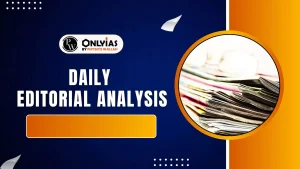Earlier this week, India’s National Security Council Secretariat hosted envoys and officials from the United States, UAE, Saudi Arabia, France, Italy, Germany, Israel, Jordan and the European Union, to discuss progress on the India-Middle East-Europe Economic Corridor (IMEC).
About IMEC
- The India-Middle East-Europe Economic Corridor (IMEC), announced at the G20 Summit in New Delhi in 2023, was envisioned as a connectivity corridor linking Asia, the Arabian Gulf, and Europe.
- Its primary objective was to significantly reduce transit times and enhance trade efficiency.
- Structure of IMEC: The corridor comprised two distinct branches:
- Eastern Leg: Connecting India’s western ports to the UAE.
- Northern Leg: Linking the Gulf (UAE, Saudi Arabia) to Europe, passing through Jordan, Israel (specifically Haifa), Greece, and Italy.
The Pre-War Context of Stability
When IMEC was unveiled in 2023, the Middle East was experiencing a period of relative stability. This favourable environment included:
- Normalisation of relations between Qatar and Gulf Cooperation Council (GCC) countries.
- A thaw in relations between Iran and Saudi Arabia.
- Increased cooperation between Arab nations and Israel following the Abraham Accords.
- Saudi Arabia and Israel were moving closer towards normalising their ties.
- Arab countries appeared to be softening their stance on the Palestinian issue.
This perceived stability provided a fertile ground for such a massive infrastructure project, leading to optimism about its success.
Benefits of IMEC
- Faster Trade Routes: The IMEC project would reduce shipping time from Mumbai to Europe from the current 17–20 days via the Red Sea to just 10–12 days.
- Multi-Modal Connectivity: The corridor would integrate electricity and digital cables to enhance energy and communication links.
- It would also include hydrogen pipelines to facilitate clean energy transport between regions.
- Trade Facilitation Measures: The project would simplify tariffs to make cross-border trade faster and more efficient.
- It would establish a corridor-wide insurance system to reduce risks for traders and investors.
- Port Infrastructure Development: Key ports along the corridor would undergo major capacity upgrades to accommodate higher cargo volumes.
Current Status of IMEC
- Challenges in the Northern Leg: The Northern Leg of IMEC, which passes through Jordan and Israel, has deteriorated to their lowest point.
- Jordan firmly rejects any displacement of the Palestinian population, a stance that often clashes with Israel’s policies and intentions, including its stated aim to reoccupy Gaza.
- Israel’s Gaza War: The outbreak of the Gaza War in October 2023 between Hamas and Israel fundamentally altered the regional landscape.
- Stalled Saudi–Israel Normalisation: Efforts to normalise relations between Saudi Arabia and Israel have stalled.
- Saudi Arabia now conditions normalisation on Israel’s recognition of Palestinian statehood, which contradicts Israel’s current position.
- Rising Trade Risks: Even if the corridor moves forward, escalating tensions in the Middle East—especially between Israel and Iran—would drive up insurance costs for goods transported along this route.
- Viability of the India–Gulf Leg: The India-to-Gulf section of IMEC is still viewed as feasible due to India’s strong bilateral relations with both the UAE and Saudi Arabia.
- Uncertainty in the Gulf–Europe Link: The larger and more ambitious Gulf-to-Europe segment remains uncertain amid the current geopolitical situation.
Conclusion
What was once hailed as a “blessing” and a “fruit of stability” is now seen as a stalled project, unlikely to progress until peace and stability return to the region.
![]() 11 Aug 2025
11 Aug 2025

